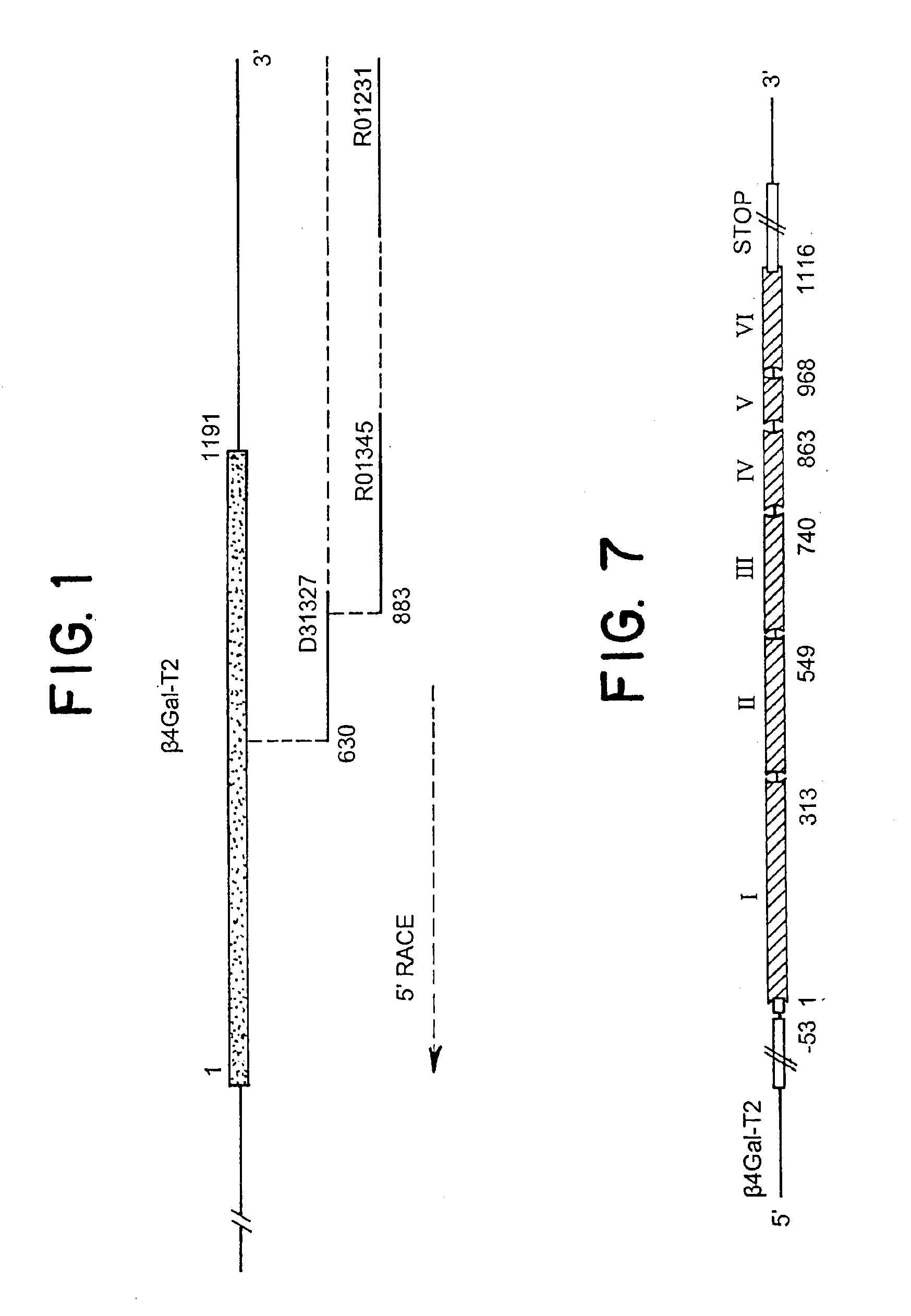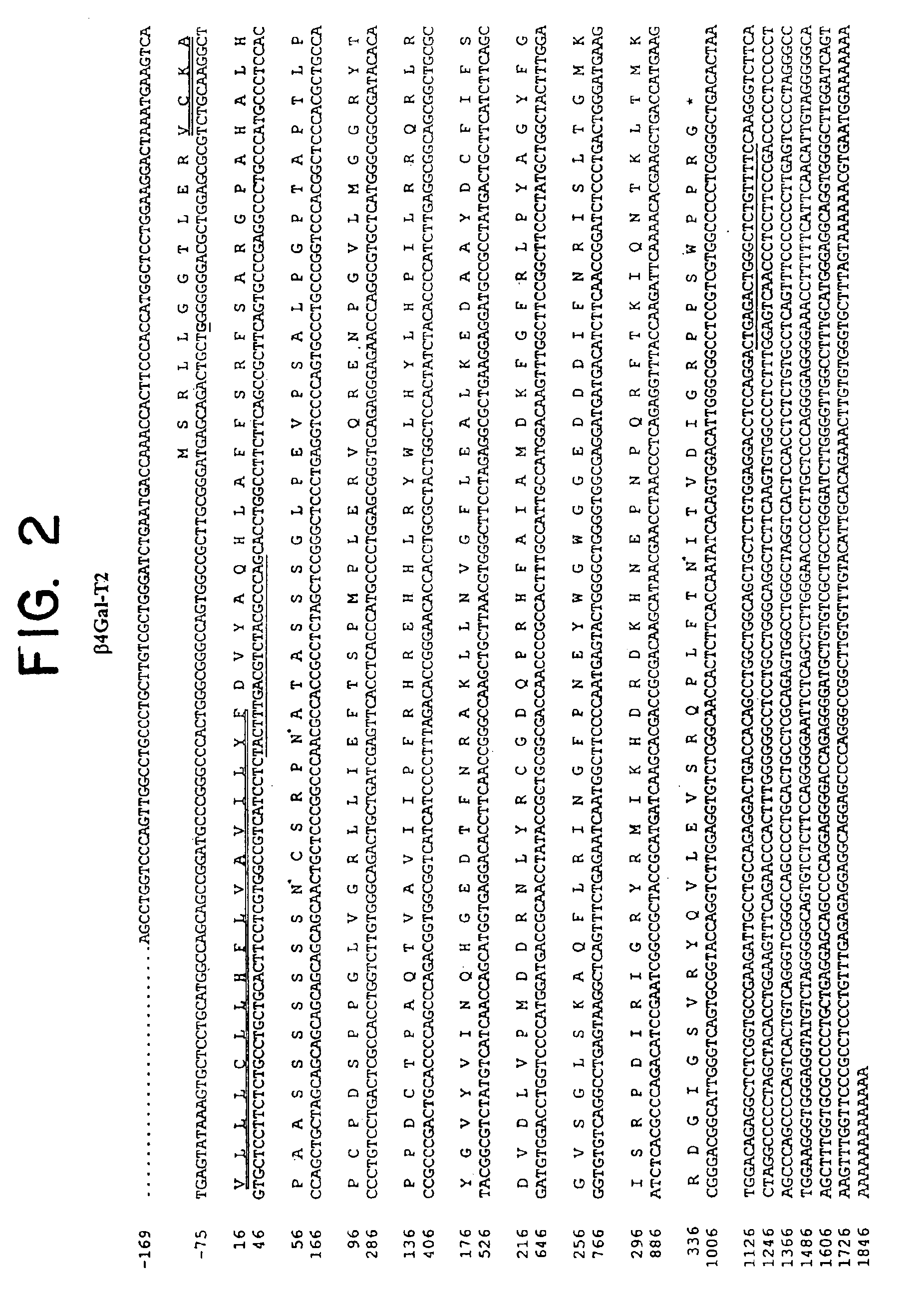UDP-galactose: β-N-acetyl-glucosamine β-1,4-galactosyltransferase, β4Gal-T2
- Summary
- Abstract
- Description
- Claims
- Application Information
AI Technical Summary
Benefits of technology
Problems solved by technology
Method used
Image
Examples
example 1
A: Identification of cDNA Homologous to b4Gal-T1 by Analysis of EST Database Sequence Information.
[0064]Database searches were performed with the coding sequence of the human β4Gal-T1 sequence (Masri et al., 1988) using the BLASTn and tBLASTn algorithms against the dbEST database at The National Center for Biotechnology Information, USA. The BLASTn algorithm was used to identify ESTs representing the query gene (identities of ≦95%), whereas tBLASTn was used to identify non-identical, but similar EST sequences. ESTs with 50-90% nucleotide sequence identity were regarded as different from the query sequence. The results of tBLASTn searches were evaluated by visual inspection after elimination of ESTs regarded as identical to the query sequence (1). If new ESTs were identified, the procedure was repeated and sequences merged. In addition, all identified ESTs were analysed in the Unigene database in order to confirm that they were from the same gene transcript, and to select cDNA clones...
example 2
A. Expression of βGal-T2 in Sf9 Cells.
[0066]An expression construct designed to encode amino acid residues 31-372 of β4Gal-T2 was prepared by RT-PCR with mRNA from Colo205 cell line, using the primer pair EBER100FOR (5′-TACTTTGACGTCTACGCCCAG; SEQ ID NO: 9) and EBER114 (5′-GAAAACAGAGCCCAGCTCAG; SEQ ID NO: 10) with BamH1 restriction sites (FIG. 2). The PCR product were cloned into the BamHI site of pAcGP67 (Pharmingen), and the construct sequenced to verify correct insertion and sequence. The plasmid pAcGP67-β4Gal-T2-sol was co-transfected with Baculo-Goldä DNA (Pharmingen) as described previously (Bennett et al., 1996). Recombinant Baculo-virus were obtained after two successive amplifications in Sf9 cells grown in serum-containing medium, and titres of virus were estimated by titration in 24-well plates with monitoring of enzyme activities. Controls included pAcGP67-β4Gal-T3-sol (Almeida et al., 1997) and pAcGP67-GalNAc-T3-sol (Bennett et al., 1996).
B. Analysis of βGal-T2 Activity.
[...
example 3
Restricted Organ Expression Pattern of βGal-T2
[0071]Human Multiple Tissue northern blots were obtained from Clontech. The soluble expression construct of β4Gal-T2 was used as probe. The probe was random primed labelled using αP32dCTP (Amersham) and an oligo labelling kit (Pharmacia). The blots were probed 18 hours at 42° C. as previously described (Bennett et al., 1996), and washed 2×10 min at RT with 2×SSC, 1% Na4P202; 2×20 min at 65° C. with 0.2×SSC, 1% SDS, 1% Na4P2O2; and once 10 min with 0.2×SSC at RT.
PUM
 Login to View More
Login to View More Abstract
Description
Claims
Application Information
 Login to View More
Login to View More - R&D
- Intellectual Property
- Life Sciences
- Materials
- Tech Scout
- Unparalleled Data Quality
- Higher Quality Content
- 60% Fewer Hallucinations
Browse by: Latest US Patents, China's latest patents, Technical Efficacy Thesaurus, Application Domain, Technology Topic, Popular Technical Reports.
© 2025 PatSnap. All rights reserved.Legal|Privacy policy|Modern Slavery Act Transparency Statement|Sitemap|About US| Contact US: help@patsnap.com



